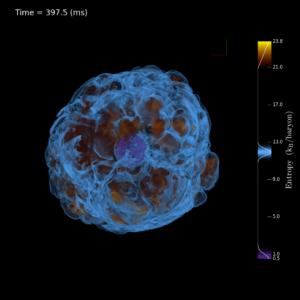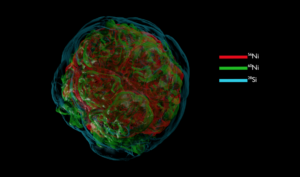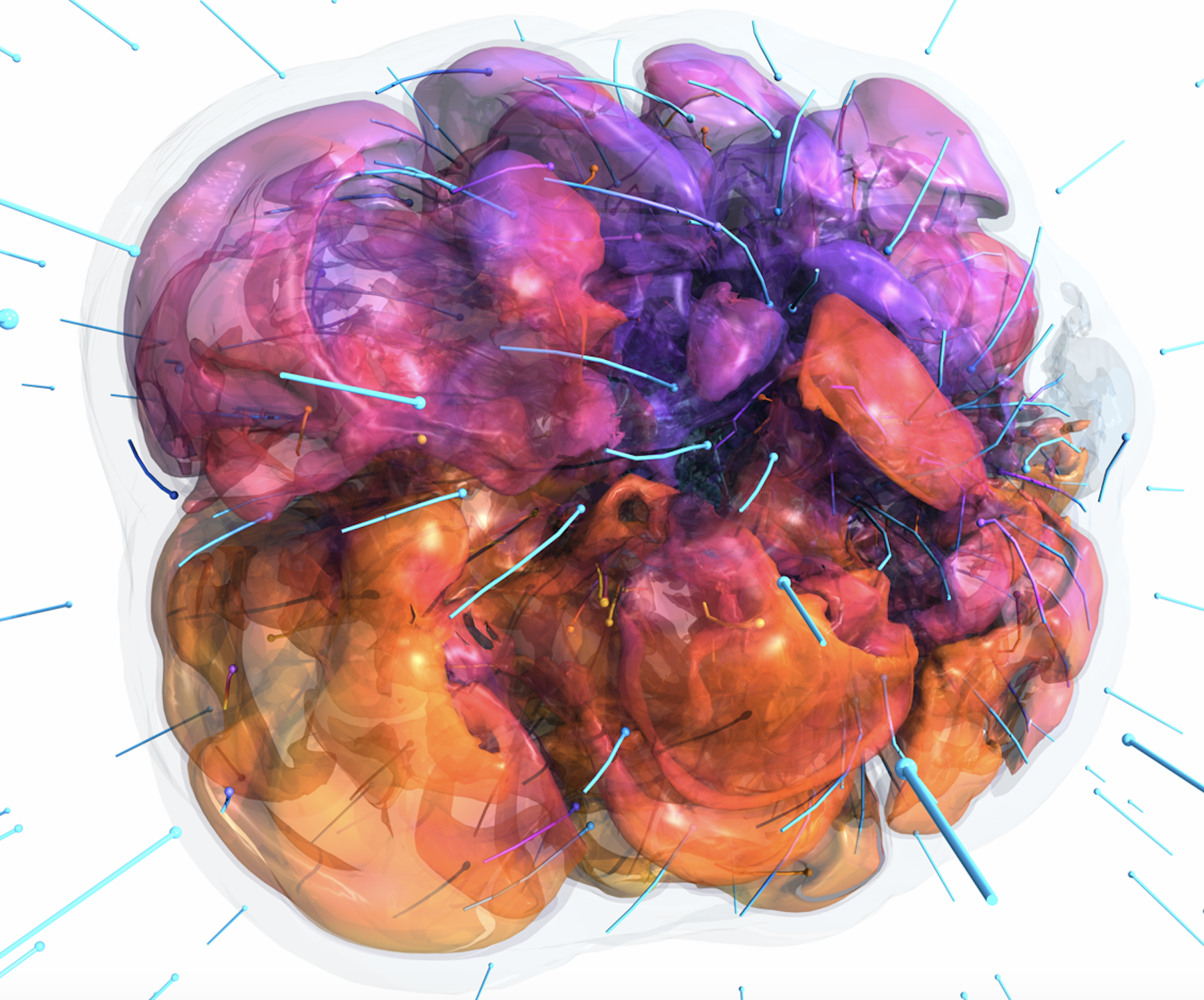Behemoth exploding stars we know as supernovae are among the wildest cosmic events astronomers witness from Earth. They are powerful enough to outshine a galaxy comprised of billions of stars, including our own Milky Way, for a few days, weeks or months. Over recorded history, some of the most powerful supernovae have even been visible in daylight.
In the past few decades, Princeton University Professor Adam Burrows and his colleagues have focused on the mechanisms that cause supernovae to burst. Though there are several types of exploding stars, the kind that commands Burrows and his team’s attention is the massive-star variety that’s roughly eight to 15 times the weight of our own sun and whose imminent death after 10 million years or so announces the birth of a neutron star, a truly oddball cosmic object.
Initially the team used Department of Energy (DOE) supercomputing time to primarily simulate the high-powered explosions – which have the potential energy of trillions upon trillions of nuclear weapons – in one or two dimensions. More recently, they’re combining advanced software coding and Argonne National Laboratory’s Cray XC40 system, named Theta, a massively parallel supercomputer to simulate many more supernovae explosions in 3-D.

Volume rendering of entropy from a 3-D simulation of a core-collapse supernova explosion, including rotation and magnetic fields. The shock wave is visible in blue; plumes of neutrino-driven convection (orange) are above the nascent neutron star (purple). This simulation was executed as part of the INCITE project “Extreme-scale Simulation of Pulsars and Magnetars from Realistic Progenitors.” Image courtesy of Sean Couch, Michigan State University.
The nature of supernovae is one of astrophysics’ greatest unsolved problems, Burrows says. “Improved calculations and techniques, coupled with access” to high-performance computing (HPC) systems, “have allowed us to gain new insights into the characteristics of supernovae explosions. That’s a breakthrough.”
These exploding stars, known as core-collapse supernovae, are heavyweights that age until they consume all the hydrogen and helium in their cores. But they still have the mass and pressure needed to fuse carbon, letting them create a suite of heavier elements, including iron, which become their new cores. In this phase these stars resemble a layered onion, with heavy elements inside and lighter elements outside.
Once the star’s iron core grows to a particular mass, searing temperatures cause it to implode, unable to resist gravity. The protons of atoms inside the core capture electrons, and extreme gravity mashes them together to create neutrons and tiny but mighty subatomic particles called neutrinos.
Then, huge amounts of infalling material bounce off the core and rebound outward. This creates a titanic shockwave, believed to contain huge amounts of neutrinos, that explodes into a massive, asymmetrical fireball and spews bubbles, tendrils and fingers of material, including all the elements found on Earth, into space.
“Think of it like a pan of boiling water,” Burrows says. “Neutrinos are heating the star material, causing it to overturn and convect, which drives turbulence. We need to get the turbulence in these simulations right to better understand the cycles of core-collapse supernovae.”
A neutron star is so dense a teaspoonful would outweigh Mt. Everest.
Neutrinos are so-called ghost particles because they have no electrical charge and whiz through space at about light speed. These particles – a million times lighter than electrons and formed celestially during the Big Bang, in supernovae and in the sun – are so ubiquitous that scientists say trillions pass, unabated, through a human body each second.
The neutron stars left behind after supernovae are packed so tightly with neutrons and neutrinos that they have a billion times the gravity of Earth. They are so dense they morph into objects as small as Philadelphia and can spin a thousand times a second. A neutron star is so dense a teaspoonful would outweigh Mt. Everest.
Most neutron stars become pulsars, which are rapidly rotating objects with significant magnetic fields. From Earth, they can look like blinking stars.
“Radiation from the magnetic poles of pulsars acts like a lighthouse beam – we see it, then it rotates out of our line of sight, then we see it when it rotates back in again,” says Sean Couch, a Michigan State University assistant professor who heads a second team awarded Argonne supercomputer time to chart supernovae properties. “We want to know how these magnetic fields form, and how pulsars are born.”
How complex are the 3-D supercomputer calculations? Depicting a second or two of a supernova’s life and death can take weeks or months.
“Our 3-D simulations have gone from just getting stars to blow up to putting our results up against real data to see if we can build a truly predictive and explanatory model of core-collapse supernovae,” Couch says. “Neutrinos are the 800-pound gorilla because they carry the vast majority of energy away from the star during the explosions.”

A map of the concentrations of three isotopies – two nickel (red and green) and one silicon (blue) – from an Oak Ridge National Laboratory (ORNL) supernova model. Image courtesy of William Raphael Hix, ORNL/University of Tennessee.
Renewal support for the core-collapse supernovae research Burrows, Couch and their respective teams conduct comes from DOE’s Innovative and Novel Computational Impact on Theory and Experiment, or INCITE program. It annually grants large chunks of HPC time to high-impact projects in science, engineering and computer science.
Burrows’ team was awarded 2 million node-hours on Theta, while Couch and his team won a million node-hours on the same machine, housed at the Argonne Leadership Computing Facility, a DOE Office of Science user facility.
A third team headed by DOE Oak Ridge National Laboratory scientist William Raphael Hix is embarking on another INCITE effort to better understand these astronomical fireworks. It’s armed with 600,000 hours on Summit, an IBM AC922 supercomputer that is the nation’s most powerful.
Hix and his colleagues are exploring how stellar rotation affects the explosion mechanism of core-collapse supernovae and associated observations. The team also is interested in simulating the raging winds that blow off the surface of newly made neutron stars during these blasts.
All three groups belong to TEAMS, for Toward Exascale Astrophysics of Mergers and Supernovae, led by Hix. It’s a DOE partnership between SciDAC (Scientific Discovery through Advanced Computing) program and the Office of Nuclear Physics.
“The fundamental problem with astrophysics, compared to other fields of physics, is we don’t get to design our experiments,” says Hix, who also is a University of Tennessee professor. “Mother Nature periodically conducts an experiment in our view, and we race to collect whatever information we can.”
